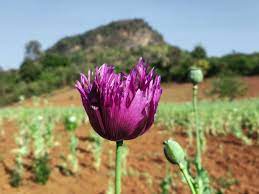Southeast Asia Opium Survey 2023: UNODC

The United Nations Office on Drugs and Crime (UNODC) has released a report titled-Southeast Asia Opium Survey 2023 – Cultivation, Production, and Implications, highlighting that there is a significant increase in Opium Cultivation in the Golden Triangle, Southeast Asia.
Highlights of the Report:
- Opium cultivation in the Golden Triangle continued to expand over the past year 2022, with a significant increase in Myanmar.
- There’s been a 18% increase in Opium cultivation in Myanmar, reaching 47,100 hectares.
- This surge has made Myanmar the world’s largest source of opium, particularly due to disruptions following the Military Takeover in 2021.
- The average estimated opium yield per hectare expanded by 16% to 22.9 kilograms/hectare.
- This reflects advancements in farming practices and increased investments in irrigation systems and fertilizers, signaling a more sophisticated approach by farmers and buyers.
- Despite an expanding supply, the price paid to farmers increased by 27% to approximately USD 355 per kilogram.
- This price surge underscores the attractiveness of opium as a crop and commodity, indicating strong demand that fuels the opium trade in the Golden Triangle.
- The report anticipates that a protracted ban on opium in Afghanistan will likely lead to sustained high prices and further increases in cultivation in Southeast Asia.
- The Taliban’s ban has led to a 95% drop in the cultivation of opium poppies in Afghanistan
- The expansion of opium cultivation contributes to a broader illicit economy in the Mekong region (Cambodia, the People’s Republic of China (specifically Yunnan Province and Guangxi Zhuang Autonomous Region), Lao People’s Democratic Republic , Myanmar, Thailand, and Viet Nam).
- It fuels synthetic drug production and a convergence of drug trafficking, money laundering, and online criminal activities, generating significant profits for organized crime groups.




